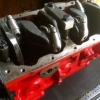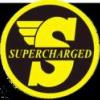Edited by ozz1, 23 April 2017 - 07:58 PM.

Idea To Reduce Con Rod Angularity In A 998
#1

Posted 23 April 2017 - 07:53 PM
#2

Posted 23 April 2017 - 07:56 PM
Hypothetically with longer rods you might gain some hp at high rpm, but at the expense of mid range torque.
Swings and roundabouts.
#3

Posted 23 April 2017 - 08:31 PM
You'd also need to address the Gudgon Pin Diameter in the Rod.
By changing the Rod Length, you are thinking the right way, re: Changing the Angle of the Rod and it could be worth setting up an engine to try, however, read on for my thoughts based on some experience here.
You'll also be changing the Rod / Stroke Ratio and this has a much bigger effect than maybe first realised - on any engine.
IMO these engines in standard form already have too long a Rod. It could be argued that going to a longer Rod reduces the Rod Angle and as you've mentioned, Piston to bore Friction, however, while that is very real,, it can easily be addressed by off-setting the Gudgon Pins in the Piston, as they already are in 1098 Pistons, just they'd need more off-set with Shorter Rods.
Increasing the Rod Length increases the Ratio. It also means that the Highest Piston Velocity occurs close to the top of the Bore and on an Intake Stroke, the Piston slows down from there. So, as the Cylinder Volume is Increasing, the Piston is slowing Down, but the time allowed to fill it is the same, so less Cylinder filling occurs.
Ideally, a short Rod is more desirable (to a Point), so that Peak Piston Velocity can occur with the Piston lower in the Bore and get better Cylinder Filling. I do realise that there appears a trend from the likes of MED to go to longer Rods, however, after looking at the Pistons, they have designed this set up around off the shelf Pistons, then had a Rod made (which they were doing in any case) to suit. I'll also point out that these Pistons have a very short Skirt and with these, the Piston to Bore Friction is higher than going to a Short Rod, even if the stock Pistons were fitted. I'm not knocking MED and I do have great respect for their products, but I don't agree with the engineering principals behind this set up. I think a few others - Swift, KAD are doing the same.
Draw yourself some diagrams to get you head around the basics of Rod / Stroke ratios. There's some info on the Internet, some is OK, some is just hype.
Also, case in point, if you look closely at the specs between a stock 998 and a stock 1098 engine, the power output of the 1098 is disproportionately higher on the 1098 and the reduced Rod / Stroke Ratio (from the increase in Stroke) is a good part of the reason for this.
Edited by Moke Spider, 23 April 2017 - 08:33 PM.
#4

Posted 23 April 2017 - 10:09 PM
1098's also had a bit better head, but the dynamics are better and your engine should using less power to turn more slowly to get similar air consumption and piston speed.
The big end caps & bolts are a somewhat different arrangement, dunno if they'd be slapping in to the cam or block???
#5

Posted 23 April 2017 - 10:38 PM
#6

Posted 23 April 2017 - 10:42 PM
I think the pistons would compensate, only one pattern of piston and offsets to either side of centre. There's still the small end dimensions, as Spider said.
#7

Posted 23 April 2017 - 10:43 PM
Just remember the extra stroke of the 1098 crank is not all in the "up" direction. The extra stroke (7.52mm) is split between the up and down direction. You might also have difficulty fitting the conrods through the smaller bore of the block?
#8

Posted 23 April 2017 - 10:53 PM
Well, you can always fit them from the bottom. Unorthodox on an A series, but on some engines you have to do it that way, simply by putting the pistons and rods in before the crankshaft.
#9

Posted 23 April 2017 - 11:19 PM
"You might also have difficulty fitting the conrods through the smaller bore of the block?" - good thinking, I suspect that's why the big end caps are arranged as they are on the 'ickle A's.
The rod length is is added to the crank throw on the up stroke but deducted at bdc.
#10

Posted 25 April 2017 - 10:50 AM
You'd also need to address the Gudgon Pin Diameter in the Rod.
By changing the Rod Length, you are thinking the right way, re: Changing the Angle of the Rod and it could be worth setting up an engine to try, however, read on for my thoughts based on some experience here.
You'll also be changing the Rod / Stroke Ratio and this has a much bigger effect than maybe first realised - on any engine.
IMO these engines in standard form already have too long a Rod. It could be argued that going to a longer Rod reduces the Rod Angle and as you've mentioned, Piston to bore Friction, however, while that is very real,, it can easily be addressed by off-setting the Gudgon Pins in the Piston, as they already are in 1098 Pistons, just they'd need more off-set with Shorter Rods.
Increasing the Rod Length increases the Ratio. It also means that the Highest Piston Velocity occurs close to the top of the Bore and on an Intake Stroke, the Piston slows down from there. So, as the Cylinder Volume is Increasing, the Piston is slowing Down, but the time allowed to fill it is the same, so less Cylinder filling occurs.
Ideally, a short Rod is more desirable (to a Point), so that Peak Piston Velocity can occur with the Piston lower in the Bore and get better Cylinder Filling. I do realise that there appears a trend from the likes of MED to go to longer Rods, however, after looking at the Pistons, they have designed this set up around off the shelf Pistons, then had a Rod made (which they were doing in any case) to suit. I'll also point out that these Pistons have a very short Skirt and with these, the Piston to Bore Friction is higher than going to a Short Rod, even if the stock Pistons were fitted. I'm not knocking MED and I do have great respect for their products, but I don't agree with the engineering principals behind this set up. I think a few others - Swift, KAD are doing the same.
Draw yourself some diagrams to get you head around the basics of Rod / Stroke ratios. There's some info on the Internet, some is OK, some is just hype.
Also, case in point, if you look closely at the specs between a stock 998 and a stock 1098 engine, the power output of the 1098 is disproportionately higher on the 1098 and the reduced Rod / Stroke Ratio (from the increase in Stroke) is a good part of the reason for this.
Very interestingbeen doing some reading and Im guessing the point in manufacturing these rods is to extend the dwell time at tdc when using a very short stroke crank to avoid out pacing the flame front at high rpms, which probably explains why the 970s had longer rods with its 60mm stroke.
Increased combustion pressure from the longer dwell time could be useful only if the crank is fast enough.
A 998 that revs to 9000 has a piston speed of 21.78ms/48.72 mph...a formula 1 car has a piston speed of 24ms/53.6mph at 18000rpm (based on a 40mm stroke)only 4.88mph faster and has a high rod ratio. Whilst the piston speed is similar the distance it travels in the bore is greater in a 998 and so takes longer to get from bdc to tdc so I dont know if this is fast enough to outpace the speed of combustion, or how you would calculate this.
So short rods help low rpm power and longer rods high end power (to a point)...I'm wondering how manufacturers calculate this (optimal) critical 'point'?
#11

Posted 25 April 2017 - 12:37 PM
It states original rod centres, (5.75ins), must remain.
#12

Posted 26 April 2017 - 06:54 AM
Very interestingbeen doing some reading and Im guessing the point in manufacturing these rods is to extend the dwell time at tdc when using a very short stroke crank to avoid out pacing the flame front at high rpms, which probably explains why the 970s had longer rods with its 60mm stroke.
Increased combustion pressure from the longer dwell time could be useful only if the crank is fast enough.
A 998 that revs to 9000 has a piston speed of 21.78ms/48.72 mph...a formula 1 car has a piston speed of 24ms/53.6mph at 18000rpm (based on a 40mm stroke)only 4.88mph faster and has a high rod ratio. Whilst the piston speed is similar the distance it travels in the bore is greater in a 998 and so takes longer to get from bdc to tdc so I dont know if this is fast enough to outpace the speed of combustion, or how you would calculate this.
So short rods help low rpm power and longer rods high end power (to a point)...I'm wondering how manufacturers calculate this (optimal) critical 'point'?
Certainly some points to think about and consider for sure.
So, what's going to produce a better outcome? More complete cylinder filling, or some dwell time at TDC? For a Fuel Mixture to Burn and make some useful Power, it needs first to be in the Cylinder. Better filling will lead to Higher BMEP (Higher Average Cylinder Pressures).
At the extremities of the stroke, regardless of the Stroke or Rod Length, for a given Crank rotation, the Piston Travel is very small. It will have some very small variations with different combinations, but these would be small to the point of being almost academic.
So, when in a Power Stoke do we want make have the Peak Cylinder Pressure occur? At TDC? I hope not! All that will do if you're lucky is hammer out the Big End Bearings, but it won't make much, if any, Power at the Crankshaft.
There are a number of factors that come in to play, but as a good guide, most engines 'like' the Peak Pressure to occur at around 140 ATDC. This being the case, having any added dwell time at TDC isn't going to help make any extra power, it can however make for some interesting needs for ignition timing.
One thing any Piston Dwell will do however, is allow the Fuel Mixture in the Cylinder / Combustion Chamber to 'reduce' in Atomisation, which will reduce Power.
Keep in mind what it is that Moves the Piston, it's not the Crankshaft, it is the Expanding Gases above the Crown, so while these Gases are actually Expanding and exerting Energy, the Pistons can't 'outpace' them.
The 970 Cooper S Engine had longer Rods only to get the Piston Crown high enough at TDC in the Bore so that it would have a respectable CR, nothing more. In these Big Bore Engines, the 970, 1071 and 1275, they all used the same Piston (and Bore Size) but, as you are already aware, had different Strokes to attain these different displacements. Starting off with the 1275, these had the 5.75" length Rods. To use the same Piston in a 1071, which was effectively a shorter Stroke 1275 and get the Piston high enough at TDC, they shaved 3/8" off the top of the Block, moving on to the 970, they used the same configuration as the 1071, but lengthened the Rod to reach their outcome. It wasn't done for any changes or optimisation of Rod / Stroke Ratios, but one of Production Cost.
These days, the trend with modern engines to to aim for a Rod / Stroke Ratio of around 1.6:1. The 998 Engine has a Ratio of 1.91:1 and the 1098 has a Ratio of 1.74:1 - a big difference between them. Fitting 6" Rods to a 998 will give it a Ratio of 2:1. Very much going in the wrong direction.
Edited by Moke Spider, 26 April 2017 - 06:55 AM.
#13

Posted 26 April 2017 - 10:56 AM
For effects on combustion you're talking about changes in volume. Any length of crank has a circular orbit so relation between crank rotation and piston travel will be the same for all engines.
It's a bit of a mind bender but I don't think the con rod length alters that - if you break it down in to vectors, the vertical one the piston travels on is still tied to the crank rotation - tdc is still tdc and at 90 degrees the piston will still be half way down the bore. What does alter is the angularity of the con rod and so how much vertical piston vector it is transmitting to the crank and when, and in what proportions, it's turning the engine or just stretching the crank webs.
Longer rods seem better, but there must be a trade off against reciprocating mass
Another issue is complying with a constant crank rotational speed, if the combustion pressure is too peaky more power will go in to stressing and vibrating the crank.
#14

Posted 26 April 2017 - 11:49 AM
It's a bit of a mind bender
At first, yes.
For effects on combustion you're talking about changes in volume. Any length of crank has a circular orbit so relation between crank rotation and piston travel will be the same for all engines.
..........
but I don't think the con rod length alters that - if you break it down in to vectors, the vertical one the piston travels on is still tied to the crank rotation - tdc is still tdc and at 90 degrees the piston will still be half way down the bore.
No, not remotely.
Draw a few diagrams.
Edited by Moke Spider, 26 April 2017 - 11:50 AM.
#15

Posted 26 April 2017 - 01:23 PM
Don't think we need to,
At TDC the piston is stationary because the crank is only moving perpendicular to it, at BDC it's the same. The crank is moving parallel to the piston at mid stroke: where the piston ceases accelerating and begins decelerating towards rest at BDC. At 45o past TDC the crank will be moving horizontally as fast as it's moving vertically, the piston is restrained by the cylinder, so can only move vertically. It must do so at the same rate as the crank because the con rod must drive (or be driven by) the crank at the same horizontal and vertical rates (any point along the rod is moving along equal horizontal and vertical vectors) if it isn't flexed, stretched or compressed...
The crank and gudgeon pins are stationary relative to each other by virtue of having a solid conrod tying them together, you can treat either end as a pivot. The movement of any point along the rod about the pivot (let's say the gudgeon pin) describes a concentric circle with any other, diminishing to zero at the pivot. Consequently the conrod itself can't impart any movement on the piston. It can only move vertically because of the cylinder and it can only do so at the same rate as the crank pin.
1 user(s) are reading this topic
0 members, 1 guests, 0 anonymous users

















